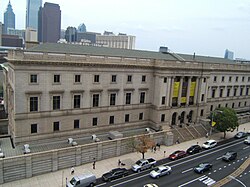쿠비즈카
Kubizuka구비즈카(首首, 문자 그대로 목걸이, 흔히 머리 무덤으로 번역됨)는 전투와 싸움에서 죽거나 포로로 잡히거나 참수형에 처해져 머리가 잘린 영혼들을 위해 일본에서 만든 무덤이다.
일본에서는 전쟁 수행이 전투로 희생된 사람들의 머리를 확인함으로써 검증되었다. 그 머리를 위로하기 위해, 많은 쿠비즈카가 세워졌다.
쿠비즈카에는 단 한 사람(적 사무라이 지휘관처럼)을 봉안하고 있어 나중에 복수심에 불타는 온리요가 되지 않고, 구비즈카는 비록 조효(공통병사)임에도 불구하고 한 번의 전투에서 전사하는 많은 병사(세키가하라 전투와 같은 거위)를 함께 봉안하고 있다. 두 가지 유형의 쿠비즈카 모두 자에 여전히 많이 존재한다.팬을 돌리다
관련 과목
때문에 발목을 해외에서 잘린 머리를 가져오는 것은 불가능했다 한국(1592–1598)의 일본 침략에 살해되는 한국과 중국 군인과 civilians[4]의 코와 묻혀 머리의 대체물이, 모여 있던 귀 무덤(耳塚, 귀 봉분, 원본 hanazuka 鼻塚의 변화가 있고, 코 mound[1][2][3])은 무덤이다;i.t는 다음 sa다나는 쿠비즈카라는 상징적인 의미를 가지고 있다.현재의 도요쿠니 신사(교토) 앞쪽 부근에 있으며, 원래는 교토시 히가시야마구 호코지사 대문 앞에 있었다.
일본 건너 쿠비즈카
- 아케치 미쓰히데의 구비즈카: 교토 시라카와 도리 거리 산조 사가루(산조 남쪽에 있음)의 모치토라 과자점변에 위치한다.
- 구마모토 현 가미야마쿠사의 하라 성 유적에 위치한 아마쿠사 시로(세닌즈카 - 1000명 분묘라고도 한다)의 구비즈카.
- 아사리 가쓰요리의 구비즈카: 아키타 노시로 히야마에 위치한다.
- 아시카가 요시노리의 쿠비즈카:신조 안코쿠지 사, 가토, 효고.
- 베쇼 나가하루의 구비즈카 : 미키, 효고.
- 가와나카지마 전투에서 죽은 자들을 위한 쿠비즈카:내부의 쿠비즈카 2명, 나가노의 하치만파라 유적지 바깥쪽 1명.
- 요시나카 기소의 구비즈카: 교토 시 야스이 히가시야마 야스이 시 야사카노토 파고다에 위치한다.
- 쿠스노키 마사시게의 쿠비즈카:오사카부 가와치나가노시 테라모토 간신지사
- 코마키와 나가쿠테 전투에서 죽은 사람을 위한 쿠비즈카: 아이치 현 나가쿠테의 야자코에 위치한다.
- 곤도 이사미의 쿠비즈카: 오카자키시 모토주쿠 호조지사에 위치한다.
- 소가노 이루카의 쿠비즈카:나라 아스카에 위치한다.
- 다이라노 마사카도의 구비즈카: 도쿄 도 치요다 시 오테마치 시에 위치한다.
- 닛타 요시사다 현의 구비즈카: 교토 시 다키구치 데라 사가노
- 마쓰다이라 노부야스의 구비즈카: 아이치 현 오카자키 시 아사히초 모리구로 시에 위치한다.
- 구비즈카 오니:기후, 미타케, 오니와 공원 21번 국도를 따라 위치한다.
- 야마구치 무네나가의 쿠비즈카:이시카와 현 가가 시 다이쇼지 신초.
- 1657년 코리 데블의 기독교 순교자 쿠비즈카 : 나가사키 오무라 하라구치 주민센터 앞.
참조
- ^ Cho, Chung-hwa (1996). Dashi ssunum imjin waeran-sa (A Revelation of the History of the Imjin War). Seoul: Hakmin-sa.
According to Cho Chung-hwa, this name change was made by the government-sponsored scholar Hayashi Rasan (1583–1657) in the early years of the Tokugawa era.
- ^ Hawley, Samuel (2005). The Imjin War: Japan's Sixteenth Century Invasion of Korea and Attempt to Conquer China. Royal Asiatic Society. p. 501. ISBN 89-954424-2-5.
- ^ The Inseparable Trinity: Japan's Relations with China and Korea, (in The Cambridge History of Japan. Vol. 4, Early Modern Japan). Cambridge University Press. 1991. pp. 235–300. doi:10.1017/CHOL9780521223553.007.
- ^ Turnbull, Stephen (2002). Samurai Invasion: Japan's Korean War 1592–1598. Cassell. p. 230. ISBN 0-304-35948-3.
Motoyama Yasumasa's account does not fail to mention that many of the noses and ears interred therein were not of fighting soldiers but ordinary civilians, because `Men and women, down to newborn infants, all were wiped out, none was left alive. Their noses were sliced off and pickled in salt.'


